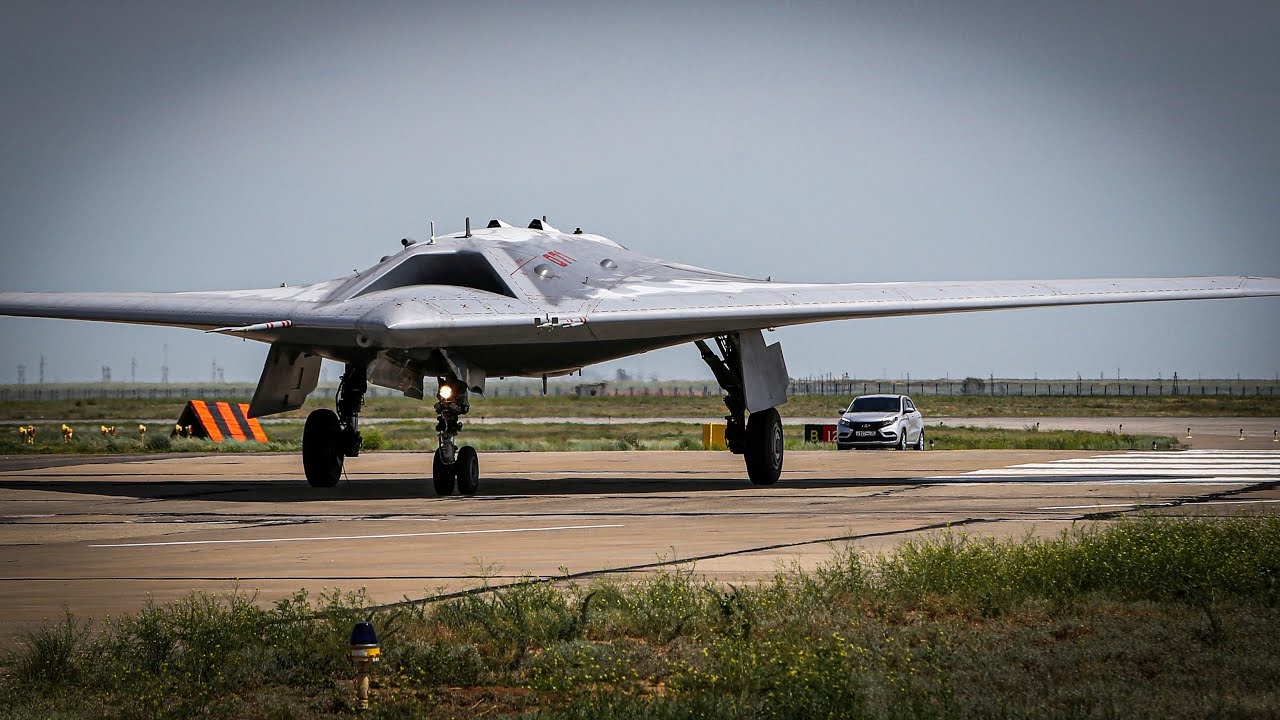The S-70 is Russia’s attempt to create a new sort of UAV or drone that leverages stealth technology. However, while this seems like a smart idea, it will take years of testing and steady budgets to make that happen. We asked our in-house Russian military expert to break down this latest development: Russia’s S-70 drone, otherwise known as the Okhotnik-B, is a Russian drone currently under development designed to complement Russia’s fifth-generation Su-57 fighter. In what is claimed to be a milestone in its development, the S-70 has reportedly successfully completed its first precision strike tests. However, most of what we know about the advanced drone is based on whatever information is allowed to escape Russia by the Russian defense industry, and therefore should be taken with a heaping pile of salt.
The S-70 Okhotnik-B’s Latest Tests
On May 28, Russian state media reported that the Okhotnik-B had completed a series of precision strike tests on ground targets. In keeping with its parallel development with the Su-57 Felon multirole fighter, the recent S-70 tests saw the drone employ missiles used by the Su-57 in its test strikes. The source in Russia’s defense industry speaking with Russian state media additionally claimed that the drone had already demonstrated its ability to drop unguided bombs, which was later confirmed by video footage published by the Russian Ministry of Defense. According to this state media readout, the S-70 successfully struck a variety of targets in different weather conditions and times of day, some of which were “small and camouflaged.”
What is the S-70 Okhotnik-B?
Russia’s S-70 drone is the most advanced drone currently under development by Russia’s defense industry, and correspondingly few details are available on the exact capabilities of this advanced drone. Powered by one Saturn Al-41F1 engine, the Okhotnik-B can reach a maximum speed of 1,000 kilometers per hour. The Okhotnik-B is also equipped with an internal weapons bay, which serves the S-70’s intended capabilities as a stealth drone.
The S-70 shares this engine with its Su-57 cousin, which is also being developed by the Russian design bureau Sukhoi. The Okhotnik-B’s development is closely linked to the Felon’s; the S-70 is designed to act as a so-called “loyal wingman” of the Su-57. This arrangement would allow the computer on board the Su-57 to coordinate the autonomous activity of several S-70s in combat. Such a relationship may not be specific to the two aircraft, as the new Project 23900 Ivan Rogov amphibious assault ship class is also designed to operate in tandem with four Okhotnik-Bs. However, Russia’s Su-57s likely do not have the necessary computer capabilities necessary to manage such a “loyal wingman” relationship.
Russian Engineers Hope the Aircraft’s Stealth Will Pair Well with its Precision Strike Capabilities
One of the biggest technical challenges in the development of the S-70 has been making the drone fully stealth-capable. For starters, the drone’s original engine configuration without a shroud likely would have prevented it from remaining stealthy. However, the newest version of the drone, which was unveiled at the Novosibirsk Aircraft Production Association in December 2021 saw many changes to the Okhotnik-B to promote its stealth capabilities, particularly a new nozzle for the drone’s rear exhaust designed with stealth in mind. Other external elements of the S-70, such as the air intakes, exhaust vents, and antennas were either removed or otherwise altered to further streamline the Okhotnik-B.
The S-70 Okhotnik-B has been in Development For Some Time
The contract to develop and build a “heavy attack drone” for the Russian armed forces was first signed by Sukhoi and the Russian government in 2011. However, it would not be until 2019 that the drone would have its first flight.
In a report to Russian President Vladimir Putin, Yuri Slyusar, the head of Russia’s United Aircraft Corporation (which owns Sukhoi), claimed that the S-70 would see its first deliveries to the Russian Armed Forces in the first half of 2024. Despite this rosy estimate, there is no reason to believe that the Okhotnik-B’s development will proceed faster in the future than it had in its preliminary development stages.
Another potential headwind for the S-70, just as with any other advanced Russian project, is the likelihood that the Okhotnik-B will run afoul of the overburdened Russian R&D and procurement processes. These issues will be made even worse by Western sanctions on Russia that prohibit the Russian import of certain military and dual-use technologies, which have already started to bite somewhat.
Russia’s S-70 Okhotnik is certainly one of Russia’s most advanced drones, but years and many hurdles remain before they will be able to reach service in any meaningful capacity.
Still, it is important to note that the steady pace at which development on the drone has taken place could indicate that the Kremlin or Russian military has made the development of the S-70 into a priority.
Wesley Culp is a Research Fellow at the Center for the Study of the Presidency and Congress. He regularly writes on Russian and Eurasian leadership and national security topics and has been published in The Hill as well as in the Diplomatic Courier. He can be found on Twitter @WesleyJCulp.

